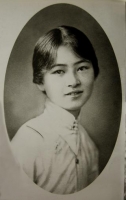| 籍贯: | 福建省闽侯 | ||
| 出生地: | 杭州 | ||
| 去世地: | 北京 | ||
阅读林徽因 Lin Huiyin在诗海的作品!!! | |||
原名徽音,福建省闽侯人。l904年6月10日生于杭州,1955年4月1日病逝于北京。1916年入北京培华女子中学,1920年4-9月随父林长民赴欧洲游历伦敦、巴黎、日内瓦、罗马、法兰克福、柏林、布鲁塞尔等地,同年人伦敦圣玛利女校学习。1921年回国复人培华女中读书。1923年参加新月社活动。1924年留学美国,入宾夕法尼亚大学美术学院,选修建筑系课程,1927年毕业,获美术学士学位。同年入耶鲁大学戏剧学院,在G.P.帕克教授工作室学习舞台美术设计。1928年3月与梁思成在加拿大渥太华结婚,婚后去欧洲考察建筑,同年8月回国,并回福州探亲。在福州期间,曾为乌石山第一中学演讲《建筑与文学》,为仓前山英华中学演讲《园林建筑艺术》,1929年出任东北大学建筑系副教授,讲授《雕塑史》和专业英语。是年,张学良出奖金征集东北大学校徽图案,林徽因设计的“白山黑水”图案中奖。1930年因患肺病到北京香山双清别墅疗养。1931年应聘到北京中国营造学社任参校。
从1931年到1946年在中国营造学社期间,参加调查研究中国古建筑,足迹遍及北京、河北、山西、浙江、河南、山东、陕西等地。
1946年后担任清华大学建筑系教授,讲授《中国建筑史》课并为研究生开设《住宅概说》等专题课。1949年参加中华人民共和国国徽设计工作,1951年为天安门广场人民英雄纪念碑碑座设计纹饰和浮雕图案,1951年调查研究景泰蓝生产工艺并设计一批具有民族风格的景泰蓝新图案,还亲自参与测试。
1950年兼任北京市都市计划委员会委员、工程师,1953年当选中国建筑学会第一届理事会理事、《建筑学报》编委、中国建筑研究委员会委员。
参与设计的工程有北京大学地质馆、灰楼学生宿舍。云南大学学生宿舍、清华大学教师住宅。中南海怀仁堂装修工程等。
她发表的有关建筑的论文主要有《论中国建筑之几个特征》、《平郊建筑杂录》(与梁思成合著)、《清式营造则例》第一章绪论、《晋汾古建筑预查纪略》(署名林徽因、梁思成)、《由天宁寺谈到建筑年代的鉴别问题》(署名林徽因、梁思成)、《中国建筑史》(辽、宋部分)、《中国建筑发展的历史阶段》(与梁思成、莫宗江合著)。
她的文学作品主要有《谁爱这不息的变幻》、《笑》、《清原》、《一天》、《激昂》、《昼梦》、《瞑想》等诗篇几十首;话剧《梅真同他们》;短篇小说《窘》。《九十九度中》等;散文《窗子以外》、《一片阳光》等。人民文学出版社出版了《林徽因诗集》(1985年);人民文学出版社与香港三联书店联合编辑出版了《林徽因》(中国现代作家选集丛书之一)。
林徽因是20世纪中国的才女。
林徽因年表:
1904年1岁
6月10日,林徽因生于浙江杭州陆官巷住宅。
原籍福建闽侯,祖父林孝恂,光绪己丑科(1889年)进士,初为政知县候选,历任浙江海宁、石门、仁和各州县,他资助青年赴日留学的学生,多参加孙中山领导的革命运动。祖母游氏,生有子女七人。
徽因父林长民(1876年生),字宗孟,为孝恂长子,1906年赴日留学,不久回国,在杭州东文学校毕业,后再度赴日早稻田大学,习政治法律;叔林天民(1887年生),字希实,早年亦留学日本,习电气工程;大姑林泽民,嫁王永昕;二姑生一女后去世;三姑林嫄民,嫁卓定谋;四姑林丘民,嫁曾仙舟;五姑林子民,嫁李石珊。
徽因之堂叔林觉民、林尹民均为黄花冈革命烈士。
1909年5岁
是年,迁居蔡官巷一宅院,林徽因随祖父母、姑母等居此,由大姑母林泽民发蒙读书。
1910年6岁
是年,林长民毕业于早稻田大学,善诗文、工书法,回国后与同学刘崇佑创办福州私立法政学堂,并任校长。
1911年7岁
是年,祖母游氏因心脏病逝世于杭州。
是年,武昌起义后,林长民赴上海、南京、北京等地宣传辛亥革命。
1912年8岁
1月1日,南京临时政府成立,林长民为福建代表,任参议院秘书长。并与汤化龙等人在上海发起组织“共和建设讨论会”
4月13日,正式成立“共和建设讨论会”,拥在日的梁启超为领袖,电其归国。
10月27日,将“共和建设讨论会”、国民协会等团体合并,林长民参与组织民主党。
是年,林长民住北京,全家由杭州移居上海,住虹口区金益里,徽因与表姐妹们人附近爱国小学,读二年级,并侍奉祖父。
1913年9岁
是年,林长民被选为众议院议员,任秘书长。母亲何雪媛(1882年—1972年,林长民第二夫人,浙江嘉兴人)带妹妹麟趾(后夭折)去北平,住前王公厂旧居,徽因留沪。
是年,林长民与第三夫人程桂林(上海人)成婚,一说1912年。
1914年10岁
是年,林长民任北京政府国务院参事,全家迁居北京。
祖父林孝恂因胆石症病逝。
是年,二娘程桂林生妹燕玉。
1915年11岁
是年,二娘程桂林生弟桓(现在美国俄亥俄美术学院任院长)。
1916年12岁
4月,袁世凯称帝后,全家迁居天津英租界红道路,林长民仍留北京。
5月,林长民去津,又同二娘程桂林回京。
秋,举家由津返京。
9月,在梁启超支持下,林长民参加并组织“宪法研究会。”
是年,林徽因与表姐们同人英国教会办的培华女子中学读书。
是年,二娘程桂林生弟恒。
1917年13岁
张勋复辟,全家迁居天津,惟徽因留京。后徽因同叔叔林天民至津寓自来水路,诸姑偕诸姊继至。林长民由宁归,独自回京。
7月17日,因支持段棋瑞讨伐张勋复辟,林长民被任命为司法总长
8月,举家由津返京。
11月15日,“安福系”崛起,林不再受重视,辞司法总长之职。
1918年14岁
3月24日,林长民与汤化龙、蓝公武赴日游历。家仍居北京南长街织女桥,徽因自信能编字画目录,及父归,阅之以为不适用,颇暗惭。但徽因料理家事,屡得其父褒奖。
是年,认识梁启超之子梁思成。
是年,成立国际联合协会中国分会,林长民是发起人之一,任协会总干事,为国联事务常住欧伦。
1919年15岁
是年,林长民任巴黎和会观察员,著书立说,抨击亲日派,反对日本承认德国在华权益。
是年,二娘程桂林生弟暄。
1920年16岁
春,林长民赴英讲学,林徽因亦随父去读中学。
3月,林长民赴瑞开国联会,由法去英,居阿门二十七号。
7月,林徽因随父到巴黎、日内瓦、罗马、法兰克福、柏林等地旅行,9月回伦敦,以优异成绩考入St.Mary′s College(圣玛莉学院)学习。
9月24日,徐志摩由美到英。
10月上旬,与在伦敦经济学院上学的徐志摩初次相遇。
1921年17岁
是年,徐志摩与林徽因有论婚嫁之意。林谓必先与夫人张幼仪离婚始可。
8月,徽因随柏烈特全家赴英南海边避暑。林长民独居伦敦。
9月14日,租屋期满,因归期延至10月14日,徽因借住柏烈特家,林长民住他处。
10月14日,徽因随父由英赴法,乘“波罗加”船归国。
11、12月间,林长民、林徽因抵上海,梁启超派人接林徽因回北京,仍进培华女中读书,林长民暂居上海。
1922年18岁
在培华女中读书。
3月,徐志摩赴柏林,经金岳霖、吴经熊作证,与张幼仪离婚。
春,林徽因、梁思成婚事“已有成言”,但未定聘。
9月,徐志摩乘船回国,10月15日抵达上海,不久北上来京,林、徐暂告不欢。
是年,二娘程桂林生弟垣。
1923年19岁
在培华女中读书。
春,新月社在西单石虎胡同七号成立,林长民、林徽因等参加并祝贺。
5月7日,梁思成带梁思永骑摩托车去追赶“国耻日”游行队伍,至南长街口被一大轿车将左腿撞断,住协和医院。彼时林徽因到医院探望。7月出院后,终身留下残疾。
是年,林长民任宪法起草委员会委员,曹锟贿选总统时,他在沪参与反直运动。
是年,林徽因经常与表姐王孟瑜,曾语儿参加新月社俱乐部文学、游艺活动。
是年,林徽因毕业于培华女中,并考取半官费留学。
1924年20岁
4月23日,印度诗哲泰戈尔来华访问,在日坛草坪讲演,林徽因搀扶上台,徐志摩担任翻译。文载:“林小姐人艳如花,和老诗人挟臂而行,加上长袍白面,郊荒岛瘦的徐志摩,犹如苍松竹梅的一幅三友图。”一时成为京城美谈。5月8日,为庆祝泰戈尔先生六十四诞辰,林徽因、徐志摩等在东单三条协和小礼堂演出泰翁诗剧《齐德拉》,林徽因饰公主齐德拉,徐志摩饰爱神玛达那。演出前,林徽因饰一古装少女恋望“新月”,以示新月社组织的这场演出活动。
泰戈尔在京期间,由林徽因、徐志摩等陪同,前往拜会了溥仪、颜惠庆。
6月,林徽因、梁思成、梁思永同往美国留学,7月7日抵达绮色佳康奈尔大学。林选户外写生和高等代数;梁选水彩静物画、户外写生和三角。
9月,结束康校暑期课程,林、梁同往宾夕法尼亚大学就读。
同月,梁思成母亲李惠仙病故。
是年,“有几个月(林徽因、梁思成)在刀山剑树上过活。比城隍庙十五殿里画出来还可怕。思成后来忏悔了。”
1925年21岁
在宾大学习。
1月18日,林徽因与闻一多等在美参加“中华戏剧改进社”。
11月22日,郭松龄在滦州倒戈反奉,通电张作霖,林长民受邀为“东北国民车”政务处长。
12月24日,郭部兵败,林长民被流弹击中,死于沈阳西南新民屯,年49岁。
1927年23岁
9月,林徽因结束宾大学业,得学士学位,后转耶鲁大学戏剧学院,在G·P·贝克教授工作室学习舞台美术半年。
12月18日,梁启超在北京为梁思成、林徽因的婚事“行文定礼”。
1928年24岁
3月,结束舞美学业。
3月21日,林徽因与梁思成在加拿大温哥华姐姐家结婚。之后按照其父梁启超的安排,赴欧洲参观古建筑,于8月
18日回京。
9月,梁思成、林徽因受聘于东北大学建筑系,分别为主任、教授。林徽因回福州探亲,受到父亲林长民创办的私立法政专科学校同人欢迎和宴请。
11月,梁启超病重住院,梁思成、林徽因赶赴北京。
1929年25岁
1月19日,梁启超病故,梁思成、林徽因为其父设计墓碑。
8月,林徽因从东北回到北平,在协和医院生下其女儿,取名再冰,意为纪念已故祖父梁启超“饮冰室”书房雅号。
是年,张学良以奖金征东北大学校徽图案,林徽因设计的“白山黑水”图案中奖。
1930年26岁
秋,徐志摩到沈阳,劝林徽因回北平治病。
12月,林徽因肺病日趋严重,协和医院大夫建议到山上静养。
1931年27岁
3月,林徽因到香山双清别墅养病。先后发表诗《那一晚》、《谁爱这不息的变幻》、《仍然》、《激昂》、《一首桃花》、《山中一个夏夜》、《笑》、《深夜里听到乐声》、《情愿》及短篇小说《窘》。
9月,梁思成、林徽因应朱启钤聘请,离开东大,到中国营造学社供职。梁任法式部主任,林为“校理”。
秋,林徽因病愈下山。
11月19日,林徽因在协和小礼堂为驻华使节讲中国古代建筑。
同日,徐志摩为听林徽因学术报告,乘机遇雨触济南党家庄开山身亡。
11月22日,林徽因、梁思成得悉徐志摩坠亡,即以铁树、白花编制小花圈,梁思成随与金岳霖、张奚若赶到徐遇难处处理后事。
同月,由林徽因等主持,在北平为徐志摩举行追悼活动。
12月7日,发表散文《悼志摩》。
1932年28岁
元旦、正月初一,分别两次致胡适信。
6月中旬,林徽因再次到香山养病。
夏,林徽因、梁思成去卧佛寺、八大处等地考察古建筑,并发表《平郊建筑杂录》。
7月至10月,作诗《莲灯》、《别丢掉》、《雨后天》。
8月,子从诫生。意为纪念宋代建筑学家李诫。
是年,在一次聚餐时林徽因结识美籍学人费正清、费慰梅夫妇。
1933年29岁
是年,林徽因参加朱光潜、梁宗岱举办的文化沙龙,每月集会一次,朗诵中外诗歌和散文。
秋,林徽因与闻一多、余上沅、杨振声、叶公超等筹备并创办了《学文》月刊。
9月,林徽因同梁思成、刘敦桢、莫宗江去山西大同考察云冈石窟。
10月7日,发表散文《闲谈关于古代建筑的一点消息》。
11月,林徽因同梁思成、莫宗江去河北正定考察古建筑。
11月18日,发表诗《秋天,这秋天》。
同月,林徽因请萧乾、沈从文到北总布胡同谈《蚕》的创作。
12月,作诗《忆》。
1934年30岁
1月,中国营造学社出版梁思成的《清式营造则例》一书,林徽因为该书写了《绪论》。
2月、5月,发表诗《年关》、《你是人间四月天》,小说《九十九度中》。
年初,为叶公超主编的《学文》月刊一卷二期设计了富有建筑美的封面。
夏,林徽因、梁思成同费正清夫妇、汉莫去山西汾阳、洪洞等地考察古建筑。
9月5日,发表散文《窗子以外》。
10月,林徽因、梁思成应浙江建设厅邀请,到杭州商讨六和塔重修计划,之后又去浙南武义宣平镇和金华天宁寺做古建筑考察。
1935年31岁
3月,林徽因与梁思成合著《晋汾古建筑预查纪略》一文。
6月,发表诗《吊玮德》,短篇小说《模影零篇:一、钟绿,二、吉公》。
10月,作诗《灵感》、《城楼上》。
11月19日,发表散文《纪念志摩去世四周年》。冬,林徽因经常与费氏夫妇到郊外练习骑马。
1936年32岁
1至11月,发表诗《深笑》、《静院》、《风筝》、《记忆》、《无题》、《题剔空菩提叶》、《黄昏过泰山》、《昼梦》、《八月的忧愁》、《冥思》、《空想外四章:你来了、“九一八”闲走、藤花前、旅途中》、《过杨柳》、《静坐》;散文《蛛丝和梅花》、《究竟怎么一回事》;短篇小说《模影零篇:三、文珍》。
5月28日,林徽因、梁思成等去河南洛阳龙门石窟、开封及山东历城、章邱、泰安、济宁等处作古建筑考察。
9月,担任《大公报》文艺作品征文评委。
10月,在《平津文化界对时局的宣言》中,向国民党当局提出抗日救亡八项要求,林徽因为文艺界发起人之一,并在宣言上签名。
是年,选编《大公报文艺丛刊小说选》并为之作序。
1937年33岁
1至7月,发表诗《红叶里的信念》、《十月独行》、《时间》、《古城春景》、《前后》、《去春》;话剧《梅真同他们》;短篇小说《模影零篇:四、绣绣》。
是年,任朱光潜主编的《文学杂志》编委。
是年,林徽因、梁思成应顾祝同邀请,到西安做小雁塔的维修计划,同时还到西安、长安、临潼、户县、耀县等处作古建筑考察。
7月,林徽因同梁思成、莫宗江、纪玉堂赴五台山考察古建筑,林徽因意外地发现榆次宋代的雨花宫及唐代佛光寺的建筑年代。
7月12日,林徽因一行到代县,得知发生“卢沟桥事变”,于是匆匆返回北平。
8月,林徽因一家从天津乘船去烟台,又从济南乘火车经徐州、郑州、武汉南下,9月中旬抵长沙。
11月下旬,日机轰炸长沙,林徽因一家险些丧生。不久,他们离开长沙,经常德、晃县、贵阳、镇宁、普安、曲靖到昆明。
1938年34岁
1月,林徽因一家住昆明翠湖前市长巡律街住宅,不久,莫宗江,陈明达、刘志平、刘敦桢也到昆明,经与中美庚款基金会联系,组建营造学社西南小分队。
是年,作诗《昆明即景:一、茶铺,二、小楼》。
1939年35岁
年初,因日机轰炸,林徽因一家搬至郊区龙泉镇麦地村。
2月5日,发表散文《彼此》。
6月28日,发表诗《除夕看花》。
冬,梁思成、刘敦桢等去云南、四川、陕西、西康等地作古建筑考察,林徽因为云南大学设计女生宿舍。
1940年36岁
初冬,营造学社随史语所入川,林徽因一家亦迁四川南溪县李庄镇上坝村。不久,林徽因肺病复发,从此抱病卧床四年。
1941年37岁
在李庄镇。
春,三弟恒在对日作战中身亡。
1942年38岁
在李庄镇。
春,作诗《一天》。
是年,梁思成接受国立编译馆委托,编写《中国建筑史》,林徽因为写作《中国建筑史》抱病阅读二十四史,作资料准备。她写了该书的第七章,五代、宋、辽、金部分,并承担了全部书稿的校阅和补充工作。
11月4日,费正清、陶孟和从重庆溯江而上,去李庄访问林徽因、梁思成。
1944年40岁
在李庄镇。
是年,作诗《十一月的小村》、《忧郁》、《哭三弟恒》。
是年,费慰梅到李庄访问林徽因。
1945年41岁
在李庄镇。
8月,日本侵略者宣布无条件投降。
是年,梁思成陪林徽因到重庆检查身体,大夫告诉思成,徽因将不久于人世。
1946年42岁
2月,林徽因在费慰梅陪同下乘机去昆明拜会西南联大校长梅贻琦,建议清华大学增设建筑系,住唐继尧后山祖居一座花园别墅,与张莫若、钱端升、金岳霖等旧友重聚。
7月31目,同西南联大教工由重庆乘机返回北平。为清华大学设计胜因院教师住宅。
10月,梁思成应聘赴美耶鲁大学作访问教授。
11月24日,发表散文《一片阳光》。
是年,作诗《对残枝》、《对北门街园子》。
1947年43岁
夏,饱经欧战浸染的萧乾,由上海来清华园探望林徽因,二人长谈七年来各自的经历。
是年,作诗《给秋天》、《人生》、《展缓》、《病中杂诗·小诗(一)、小诗(二)、写给我的大姊、恶劣的心绪》。
12月,做肾切除手术。
1948年44岁
2月18日,作诗《我们的雄鸡》。
2至5月,发表诗《空虚的薄暮》、《昆明即景》、《年青的歌》、《病中杂诗九首》、《哭三弟恒》。
11月,国民党当局迫使北平高校南迁。清华园展开反迁校斗争,林徽因说:“我们不做中国的‘白俄’。”
是年,大军攻城前夕,张奚若带两名解放军到林徽因家,请梁、林划出保护古建筑目标,为此深感新政权对他们的信任。
是年,叔林天民故。
1949年45岁
北平解放,林徽因被聘为清华大学建筑系一级教授。
2月,为百万大军挥师南下,与梁思成等编印《全国重要文物建筑简目》。
春,送女儿再冰参加南下工作团。
7月,政协筹委会决定把国徽设计任务交给清华大学和中央美院。清华大学由林徽因、李宗津、莫宗江、朱畅中等七人参加设计工作。
1950年46岁
6月,经过三个多月的努力,清华大学和中央美院设计的国徽图案完成并在中南海怀仁堂评选,经周总理广泛征求意见,清华小组设计图案以布局严谨、构图庄重而中选。
6月23日,林徽因被特邀参加全国政协一届二次会议。
9月30日,中央人民政府主席毛泽东发布国徽图案命令。
是年,林徽因被任命为北京市都市计划委员会委员兼工程师,提出修建“城墙公园”设想。
是年,妹燕玉故。
1951年47岁
是年,为挽救濒于停业的景泰蓝传统工艺,抱病与高庄、莫宗江、常莎娜、钱美华、孙君莲深入工厂做调查研究,并设计了一批具有民族风格的新颖图案,为“亚洲及太平洋区域和平会议”、“苏联文化代表团”献上一批礼品,深受与会人员欢迎。
1952年48岁
是年,梁思成、刘开渠主持设计人民英雄纪念碑,林徽因被任命为人民英雄纪念碑建筑委员会委员,抱病参加设计工作,与助手关肇邺一起,经过认真推敲,反复研究,终于完成了须弥座的图案设计。
5月,为迎接即将到来的建设高潮,林徽因、梁思成翻译了《苏联卫国战争被毁地区之重建》一书,并由上海龙门书局印行,为国家建设提供了借鉴。
是年,应《新观察》杂志之约,撰写了《中山堂》、《北海公园》、《天坛》、《颐和园》、《雍和宫》、《故宫》等一组介绍我国古建筑的文章。
1953年49岁
10月,当选为建筑学会理事;并任《建筑学报》编委。
是年,被邀参加第二届全国文代会,江丰在美术家协会的报告上,对林徽因和清华小组挽救景泰蓝的成果,给予了充分肯定和高度评价。
1954年50岁
6月,林徽因当选为北京市人民代表大会代表。
秋,林徽因不抵郊外风寒,由清华园搬到城里去住。不久,因病情恶化住同仁医院。
1955年51岁
4月1日6时20分,病逝于同仁医院。
4月2日,《北京日报》发表讣告,治丧委员会由张奚若、周培源、钱端升、钱伟长、金岳霖等13人组成。
4月3日在金鱼胡同贤良寺举行追悼会,遗体安放在八宝山革命公墓。
BiographyLin was born in Hangzhou though her family was from Minhou, Fujian. She was the daughter of Lin Changmin (林長民) (16 September 1876 - Xinmin, Liaoning, 24 December 1925) and He Xuehuan (何雪媛) (1882–1972). Raised in a wealthy family, she received the best education a woman could obtain at the time. She pursued her degrees both in England and the United States. She attended St Mary's College in London, where she became acquainted with the well known Chinese poet Xu Zhimo. Their relationship is commonly referred to in a romantic anecdote. However, according to Lin, she had never fallen in love with Xu.
In April 1924, the sixty-four-year old Indian poet Tagore visited China, Lin Huiyin and Xu Zhimo worked together to do the interpretation work for Tagore, during which Lin Huiyin distinguished herself with her fluent English and also won the admiration of the great poet.
Lin studied art at University of Pennsylvania as an undergraduate, where she also worked as a part-time assistant in the architectural department. Later, she enrolled in stage design programs in Yale University as a graduate student, pursuing her longtime interest in drama.
Upon her return to China from the United States, she helped to establish the Architectural Department in Northeastern University in Shenyang, where she then taught architecture briefly. Meanwhile, in 1928, she designed a railway station in Jilin. This was one of the few buildings Lin designed.
Throughout the 1930s, Lin and her husband, Liang Sicheng, traveled in Shanxi, Shaanxi, Shandong, Hebei, Jiangsu, and other Chinese provinces to study and record architectural relics scattered throughout these provinces. In 1937, She discovered the main hall of Foguang Temple near Doucun, Shanxi. The hall was the only remaining Tang dynasty timber structure known at the time.
In 1936, in order to do the measurement work of the Chinese ancient architecture, Lin Huiyin together with Liang Sicheng climbed the quiet solemn roof of the Temple of Heaven. She is considered as the first woman in the history of China to set foot on the emperor worship palace roof.
After 1949, Lin and Liang Siceng was involved in the design of the National Emblem of the People's Republic of China and the Monument to the People's Heroes located in the Tiananmen Square. Lin designed the floral wreath patterns at the base of the Monument to the People's Heroes.
Lin Huiyin wrote poems, essays, short stories and plays. Many of her works were praised for its subtlety, beauty, and creativity. With her husband she wrote a book named History of Chinese architecture. She also translated English works into Chinese.
She died of tuberculosis.
贡献者: 迪拜
